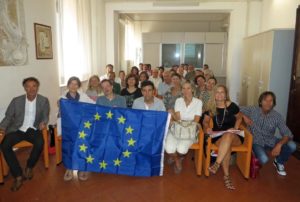The SOS4Life project gets underway
The Municipality of Forlì has hosted the kick-off meeting that officially launched the SOS4Life – Save Our Soil for Life European project, which was recently declared eligible for funding by the European Commission as part of the LIFE Environment and Resource Efficiency call.

SOS4Life is a demonstration project that aims to contribute to implementation, at municipal level, of European policies regarding soil protection and urban regeneration, with particular reference to European guidelines on best practices to limit, mitigate and compensate soil sealing. Coordinated by the Municipality of Forlì, other project partners are the Emilia-Romagna Region, the Municipalities of Carpi (MO) and San Lazzaro di Savena (BO), CNR IBiMET (Florence and Bologna Institutes of Biometeorology of the National Research Council), Unione Regionale Costruttori Edili Emilia-Romagna (or ANCE, Emilia-Romagna Regional Association of Construction Companies), Legambiente Emilia-Romagna and Forlì Mobilità Integrata srl. With an overall budget of € 1,788,749, including € 1,060,551 of EU funding, the project will be implemented by the Municipality of Forlì, in collaboration with the partners, from July 2016 to the end of October 2019.
The project has three main objectives:
- Assessment of the ecosystem services provided by urban soils and quantification of the cost and impact of land take and soil sealing, both in urban and rural contexts.
- Definition of a framework of urban regulations and implementation tools, applicable at municipal level, aimed at achieving the goal of no net land take and promoting urban regeneration; the realisation of de-sealing demonstration interventions (de-sealing of areas currently paved and sealed) as a method for compensating urbanisation of new areas and improving urban resilience to change.
- Development of an information system supporting municipal decision-making, replicable on a national and European level, to constantly monitor land-use changes and urban regeneration processes by integrating maps and urban and building practices.
This demanding project tackles topics that are in line with the new regional urban planning law currently under consideration and presents strong synergies with the new planning phase that was recently implemented, and will lead to drafting of a new Municipal Structure Plan focusing in particular on the reduction of land take and urban regeneration.


